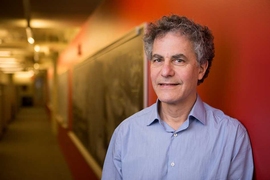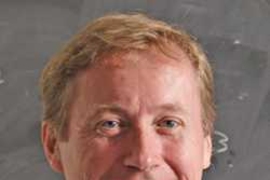Tomasz S. Mrowka, the Singer Professor of Mathematics, has been named head of the Department of Mathematics, effective immediately.
“Mathematics holds a unique place at MIT,” Mrowka said. “Much of the community uses it on a daily basis and in an ever-growing and sophisticated manner. The Mathematics department is the nexus of this activity. Its health and strength are crucial for MIT’s future.”
Mrowka has served as the interim department head since June 2014. Mrowka takes over the role from Michael Sipser, the Barton L. Weller Professor of Mathematics. Sipser was named Dean of the School of Science after serving since last December as interim dean and since 2004 as head of the Department of Mathematics.
“I am delighted that Tom has agreed to be head of mathematics,” said Sipser. “From working with him closely for many of the past 10 years while I was in that role, I know of his deep dedication to the department, to mathematics, and to MIT. He is a stellar mathematician and we are fortunate to have him in this position of leadership.”
Mrowka brings substantial experience as a researcher, educator, and administrator to his role as department head. A 1983 graduate of MIT, he received a PhD from the University of California at Berkeley in 1988 under the direction of Clifford Taubes and Robin Kirby. He taught at Stanford University, Caltech, and Harvard University before returning to MIT in 1996. He served as chair of the Graduate Student Committee from 1999 to 2002 and has chaired the Pure Mathematics Committee since 2004, with a one-year pause in 2009-2010.
Mrowka’s work combines analysis, geometry, and topology, specializing in the use of partial differential equations such as the Yang-Mills equations from particle physics to analyze low-dimensional mathematical objects. Among his results is the discovery (jointly with Robert Gompf of the University of Texas at Austin) of surprising four-dimensional models of space-time topology, going far beyond the expected examples envisaged by Kodaira and others.
In joint work with Peter Kronheimer of Harvard, Mrowka settled many long-standing conjectures, including ones posed by John Milnor on the complexity of knots in three space and another due to Rene Thom on surfaces in four space. Mrowka and Kronheimer also revealed a deep structure underlying the Donaldson invariants of four-dimensional manifolds, which was an avatar of the Seiberg-Witten invariants. In further recent work with Kronheimer, Mrowka used these tools to show that a certain subtle combinatorially-defined knot invariant introduced by Mikhail Khovanov can detect “knottedness.”
Mrowka’s joint work with Kronheimer has been honored by the American Mathematical Society with the 2007 Oswald Veblen Prize in Geometry as well as the 2010 Joseph L. Doob Prize for their monograph, "Monopoles and Three-Manifolds" (Cambridge University Press, 2007). In addition, Mrowka was elected a fellow of the American Academy of Arts and Sciences in 2007 and was named a Guggenheim fellow in 2010 and Fellow of the Radcliffe Institute for Advanced Studies in 2013.









